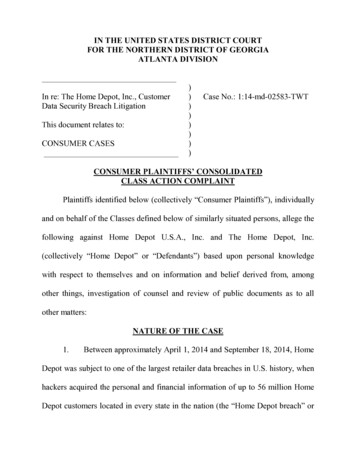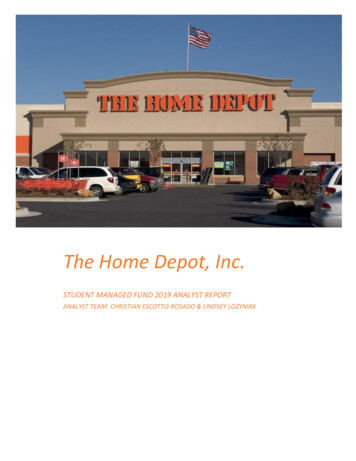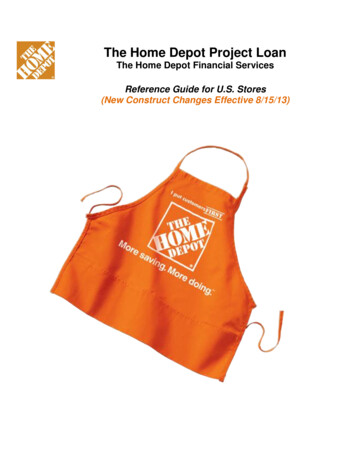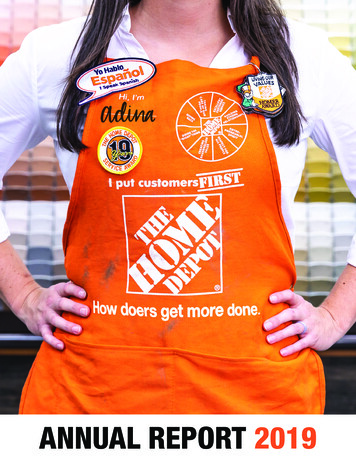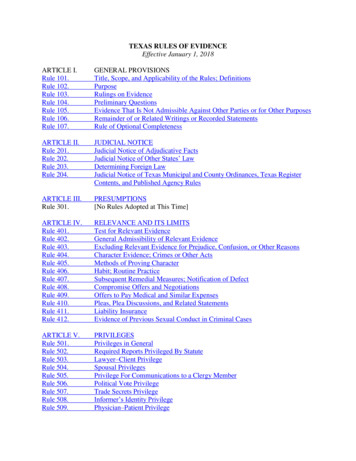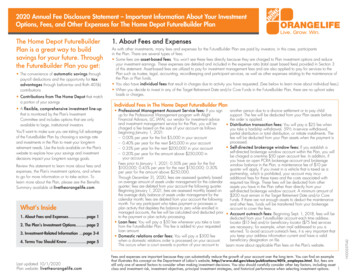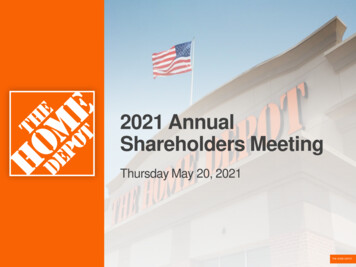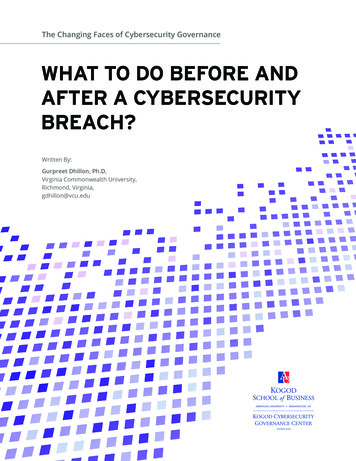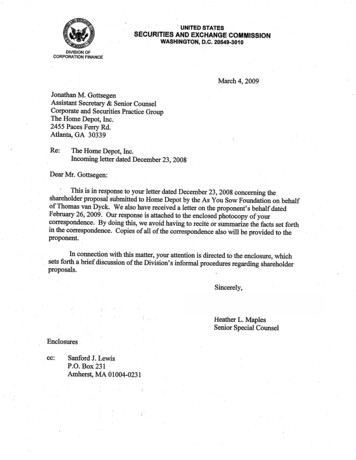
Transcription
(iUNITED STATESSECURITIES AND EXCHANGE COMMISSIONWASHINGTON, D.C. 20549-3010DIVISION OFCORPORATION FINANCEMarch 4,2009Jonathan M. GottsegenAssistat Secreta & Senior CouielCorporate and Securties Practice GroupThe Home Depot, Inc.2455 Paces Ferr Rd.Atlanta GA 30339Re: The Home Depot, Inc.Incoming letter dated December 23,2008Dear Mr. Gottsegen:Ths is in response to yourletter dated December23, 2008 concerng theshareholder proposal submitted to Home Depot by the As You Sow Foundation on behafofThomas van Dyck. We also have received a letter on the proponent's behalf datédFebruar 26,2009. Our response is attched to the enclosed photocopy ofyourcorrespondence. By doing ths, we avoid having to recite or sumarze the facts set fortin the correspondence. Copies of all of the correspondence also will be provided to theproponent.In connection with ths matter, your attention is directed to the enclosure, whichthe Division's inormal procedures regardig shareholderproposals.setsfort a bnef discussion ofSincerely,Heather L. MaplesSenior Special CounselEnclosurescc: Sanord J. LewisP.O. Box 231Amerst, MA 01004-0231
March 4, 2009Response of the Offce of Chief CounselDivision of Corporation FinanceRe: The Home Depot, Inc.Incomig letter dated December 23,2008reduceThe proposal requests that the company issue a report on policy options toconsumer exposure and increase consumer awareness regardig mercur and any othertoxins contaed in n:vision brand products.There appears to be some basis for your view that Home Depot may exclude theproposal under rue 14a-8(i)(7), as relating to Home Depot's ordinar business operationsparicular products). Accordingly, we will not recommend emorcement(i.e., the sale ofaction to the Commission if Home Depot omits the proposal from its proxy materials inreliance on rue 14a-8(i)(7). In reachig this position, we have not found it necessary toaddress the alternative bases for omission upon which Home Depot relies. Attorney-Adviser
DIVISION OF CORPORATION FINANCEINFORMAL PROCEDURES REGARDING SHAREHOLDER PROPOSALSThe Division of Corporation Finance believes that its responsibility with respect to14a-8), as with other matters under the proxyrules, is to aid those who must comply with the rule by offering informal advice and suggestionsand to determine, initially, whether or not it may be appropriate in a paricular matter torecommend enforcement action to the Commission. In connection with a shareholder proposalunder Rule 14a-8, the Division's staff considers the information furnished to it by the Companyin support of its intention to exclude the proposals from the Company's proxy materials, as wellas any information furnished by the proponent or the proponent's representative.matters arsing under Rule 14a-8 (17 CFR 240.Although Rule 14a-8(k) does not require any communications from shareholders to theCommission's s,taff, the staffwil always consider information concernng alleged violations ofthe statutes administered by the Commission, including argument as to whether or not activitiesproposed to be taken would be violative of the statute or rule involved. The receipt by the staffof such information, however, should not be constred as changing the stafrs informalprocedures and proxy review into a formal or adversar procedure.It is important to note that the stafrs and Commission's no-action responses toRule 14a-8(j) submissions reflect only informal views. The determinations reached in these no action letters do not and canot adjudicate the merits of a company's position with respect to theproposal. Only a court such as a U.S. District Court can decide whether a company is obligatedto include shareholder proposals in its proxy materials. Accordingly a discretionarydetermination not to recommend or take Commission enforcement action, does not preclude aproponent, or any shareholder of a company, from pursuing any rights he or she may have againstthe company in court, should the management omit the proposal from the company's proxymateriaL.
SANFORD J. LEWIS, ATTORNEYFebruary 26,2009Via emailOffce of Chief CounselDivision of Corporation FinanceU.S. Securties and Exchange Commission100 F Street, N.E.Washington, D.C. 20549Re: Shareholder proposal to The Home Depot, Inc. seeking a report on policy optionsregarding toxins in its private label products, submitted by the As You Sow Foundation on behalfof Mr. Thomas van DyckDear Sir/Madam:Mr. Thomas van Dyck (the "Proponent") is the beneficial owner of common stock ofThe HomeDepot, Inc. (the "Company") and has submitted a shareholder proposal (the "Proposal") to theCompany. We have been asked by the Proponent to respond to the letter dated December 23,2008, sent to the Securities and Exchange Commission Staff (the "Staff') by the Company. Inthat letter, the Company contends that the Proposal may be excluded from the Company's 2009proxy statement by vire ofRule 14a-8(i)(5), Rules 14a-8(i)(3) and 14a-9, and Rule 14a-8(i)(7).We have reviewed the Proposal, as well as the letter sent by the Company, and based upon theforegoing, as well as the aforementioned Rules, it is our opinion that the Proposal must beincluded in the Company's 2009 proxy materials and that it is not excludable by vire ofthoseRules.Pursuant to StaffLegal Bulletin 14D, a copy ofthis letter is being sent via fax concurrently toJonathan Gottsegen, Assistant Secretar & Senior Counsel, The Home Depot Inc.SummaryThe shareholder Proposal relates to a flagship product of Home Depot which theatens to causehome environments in the event ofbreakage. The resolution seeks toensure that the Company engages in adequate measures to reduce har to the environment byensuring that consumers are prepared to act effectively when the bulbs break. Because this is aproduct upon which Home Depot is staking its environmentally sensitive reputation, the fact thatit represents less than 5% of cash flow to the Company does not make it irrelevant to theCompany's operations for puroses ofrule 14a(i)(5). The resolution is not vague or indefinitebut adequately informs shareholders of what is requested of the Company. The resolution is notexcludable under the ordinary business exclusion because it relates to environmental harmercur contamination ofreduction measures consistent with StaffLegal Bulletin 14C.PO Box 231 Amherst, MA 01004-0231 · sanfordlewiS(fstrategiccounse1.net413 549-7333 ph. 781207-7895 fax
The Home Depot Inc. - Proposal for Report re Toxics in Private Label Products Page 2Proponent Response - Februar 26,2009The ProposalFor the convenience ofthe Staff, the Proposal in its entirety states:Home DepotWhereas compact fluorescent lamps (CFL) manufactued for Home Depot are positive, energy saving products that save up to 75% in energy cost and last far longer than incandescent bulbs.However, CFLs contain mercur and therefore pose health risks to consumers when brokenrequiring appropriate package labeling and risk disclosure.the National Electrcal Manufacturers Association (NMA) LampSection Technical Committee has stated that "it is to the lighting industry's advantage to limit thetotal mercur content of CFLs and to work with all stakeholders so that CFLs are managed in anenvironmentally responsible maner at end-of-life."Ed Yandek, chairman ofCurrent technology requires mercury for operation of fluorescent lamps, but accidental exposureto mercur in the bulbs through consumer breakage poses potential threats to environmentalhealth. Overexposure to mercur can result in respiratory failure, affect kidney and brainfuctions, and cause long-term neurobehaviora1 problems in children whose mothers wereexposed durng pregnancy (htt://ww.oehha.ca.gov/air/toxic contaminants/pdt- zipIMercuryostSRP3 .pdf pI).safe exposure ofmercury in the air at 300nanograms/cubic meter.The Centers for Disease Control consider minimal risk to be at 200 nanograms/cubic meter.Studies indicate that a broken CFL with 5mg of mercur can produce mercur vapor levels wellin excess ofthese levels - from 8,000 to 150,000 nanograms/cubic 08/08/final shedding Iight al1.pdf pp 4, 6, 7).EPA has estalJlished a level ofSome public health experts assert that consumers need disclosure of the amount of mercurpresent in each individual lamp, not a broad average or range, in order to make informedpurchasing decisions based on environmental impact and potential threat to human health. Othersassert that packaging should also include information on clean-up procedures to be followed byconsumers when bulbs break as recommended by Environmental Protection Agency (EPA).Resolved: Shareholders request the company to issue a report, at reasonable expense andomitting confidential information, on policy options to reduce consumer exposure and increaseconsumer awareness regarding mercur and any other toxins contained in its private labeln:vision brand products.Supporting Statement: Proponents believe the report should, among other things, discusspolicy ideas such as the labeling of mercur levels in products, providing consumers withinformation on cleanup procedures, and whether Home Depot policy could be shaped to helpdrive development ofnon-mercury, energy saving, lighting alternates. We believe providingmercur content information on the package could give Home Depot's n:vision brand products apotential advantage over its competition and provide a valuable service to consumers insituations where CFL breakage could pose health threats to family members or pets. Providing
The Home Depot Inc. - Proposal for Report re Toxics in Private Label Products Page 3Proponent Response - February 26,2009clean up information with each package would allow consumers to be informed and ready tofollow proper procedures before accidents happen, eliminating the need for urgent calls to localauthorities after product breakage.BackeroundThe issue of mercur content of energy-saving light bulbs has grown in importance. Across theeconomy, consumers and businesses are being encouraged to deploy energy-saving technologies,including compact fluorescent lamps (CFLs). These light bulbs are being sold in staggeringnumbers. The energy savings of CFLs over incandescent bulbs is substantial and is a driver forgovernment promotion policies and booming sales. So far, however, very little emphasis is beingplaced on either the risks of a fragile mercur containing product in the home or the need tohandle and dispose of these bulbs safely. The issue is being given surrisingly little attentiondespite the risk to consumers, especially young members of families and pets, by their proximityto floors and carpets where exposure to mercur from broken bulbs is highest, could be exposedto harmful levels ofmercur in the event ofbulb breakage.Lightbulbs break. We all have broken and cleaned up broken bulbs. In the absence of specificmandates 1, many consumers are not even aware that CFLs are not to be cleaned up in the sameway as an incandescent bulb. After breakage, consumers might tyically use a vacuum or broomto clean up the bulb - but this common sense reflex is inappropriate and hazardous. Home Depotprivate label bulbs, n:vision, do not indicate the needed clean up procedures.Attention to the environmental risks of these broken bulbs has been overshadowed by the mediablitz touting the energy savings of CFLs. But awareness of the special requirements for CFLs isgrowing as is media coverage of the environmental hazards of the broken bulbs.For instance, TheStreet.com, Januar 9, 2009 noted:. Should you break one, the EPA lists on its Web site some extremely alarminginstructions for how to clean up mercury. (Vacuuming, it seems, is a big no-no).i In contrast to the lack of mandates in the US, in Europe the Eco-Design directive enacted in 2005 prescribesstandards for CFL bulbs and their labeling. The directive requires that the label contain certain information, parallelto what is requested by the resolution:Ifthe lamp contains mercury:(k) Lamp mercur content as X.X mg;(1) Indication of which website to consult in case of accidentallamp breakage to find instrctions on how toclean up the lamp debris.European Eco-design Directive, ANNEX II, Section 3.1Ecodesign requirements for non-directional household lampsThere are numerous precedents in the US for shareholders and other stakeholders to urge companies to reduceenvironmental and health concerns addressed under European laws and directives in advance oftheir adoption in theUS. The European directive demonstrates the seriousness of the policy challenge that these issues raise, and raisesthe stakes for US companies in the absence of specific mandates.
The Home Depot Inc. - Proposal for Report re Toxics in Private Label Products Page 4Proponent Response - February 26, 2009- The mercur means these are considered hazardous waste and you should not blithelythrow them into your household trash.A column in the Statesman Joural (Salem, Oregon, Sept 4, 2008), went into more depth aboutthe concern:Back in 2001, some 8.4 milion compact fluorescent light bulbs were distributed in theNortwest, spearheading the campaign to get the public to switch from incandescent bulbs tothe more energy-effcient CFLs.Right now, according to Portland General Electric, those bulbs are reaching the end oftheir life span and buring out. But replacing them isn't as easy as just tossing out the old andscrewing in the new.CFL bulbs contain mercur, a powerfl neurotoxin that poses serious health risks,especially for children. Already, researchers have linked mercur toxicity to birth defects,autism, Alzheimer's disease, Parkinson's disease, multiple sclerosis, fibromyalgia, lupus,chronic fatigue syndrome, arhritis, depression, bipolar disorder and other conditions.The National Institute ofEnvironmental Health Sciences' Web site says, "Mercuryvapor inhalation can cause signifcant neural damage in developing fetuses andchildren. "Stil think CFLs pose no risk? Read the EPA's instructions on what to do if one breaks.First, evacuate children and pets from the area. Then, ventilate the room for 15minutes, shut off the central forced-air heating/air conditioning system to keep thefumes from circulating through the house, carefully scoop up the pieces with cardboardor duct tape and place them in a glass jar with a metal lid (such as a canning jar) or in asealed plastic bag! Whatever you do, don't use a vacuum or broom!Broken bulbs, in short, have to be treated as toxic waste and are so potentiallyharmful that some states have made it against the law to put them in with the trash.That's just one bulb. Can you imagine what wil happen when a good portion of those8.4 milion CFLs make their way to the landfill? True, people are warned not to put thebulbs into the trash, but it's estimated that only 3 percent of all CFLs are properlydisposed of.These are staggering statistics, and the foundation of a serious environmental health threat toall Americans using CFLs in their homes, and to the environment affected by mercur leachinginto the soil and water from landfills.For those who, despite lack of clear signals from Home Depot, go to the EnvironmentalProtection Agency website to lear how to clean up broken CFLS, they wil find those veryspecific instructions. These Environmental Protection Agency instructions do not appear on orin the box ofHome Depot distributed products2:How should I clean UP a broken fluorescent bulb?Because CFLs contain a small amount ofmercur, EPA recommends the following clean-up and disposalguidelines:2 htt://www .energystar.gov/ia/partners/promotions/change light/downloadsIFacI-SheeI-Mercury .pdf
The Home Depot Inc. - Proposal for Report re Toxics in Private Label Products Page 5Proponent Response - February 26,20091. Before Clean-up: Air Out the Room. Have people and pets leave the room, and don't let anyone walk through the breakage area on theirway out. Open a window and leave the room for 15 minutes or more. Shut offthe central forced-air heating/air conditioning system, ifyou have one.2. Clean-Up Steps for Hard Surfaces. Carefully scoop up glass fragments and powder using stiff paper or cardboard and place them in aglass jar with metallid (such as a canning jar) or in a sealed plastic bag. Use sticky tape, such as duct tape, to pick up any remaining small glass pieces and powder. Wipe the area clean with damp paper towels or disposable wet wipes. Place towels in the glass jar orplastic bag. Do not use a vacuum or broom to clean up the broken bulb on hard sudaces.3. Clean-up Steps for Carpetinii: or Rul!:. Carefully pick up glass fragments and place them in a glass jar with metal lid (such as a canning jar)or in a sealed plastic bag. Use sticky tape, such as duct tape, to pick up any remaining small glass fragments and powder. If vacuuming is needed after all visible materials are removed, vacuum the area where the bulb wasbroken. Remove the vacuum bag (or empty and wipe the canister), and put the bag or vacuum debris in asealed plastic bag.4. Clean-up Steps for Clothinl!. Beddinl!. etc.:. If clothing or bedding materials come in direct contact with broken glass or mercury-containingpowder from inside the bulb that may stick to the fabric, the clothing or bedding should be thrownaway. Do not wash such clothing or bedding because mercury fragments in the clothing maycontaminate the machine and/or pollute sewage. You can, however, wash clothing or other materials that have been exposed to the mercury vaporfrom a broken CFL, such as the clothing you are wearing when you cleaned up the broken CFL, aslong as that clothing has not come into direct contact with the materials from the broken bulb. If shoes come into direct contact with broken glass or mercury-containing powder from the bulb,wipe them offwith damp paper towels or disposable wet wipes. Place the towels or wipes in aglass jar or plastic bag for disposaL.5. Disposal of Clean-up Materials. Immediately place all clean-up materials outdoors in a trash container or protected area for the nextnormal trash pickup. Wash your hands after disposing of the jars or plastic bags containing clean-up materials. Check with your local or state governent about disposal requirements in your specific area. Somestates do not allow such trash disposaL. Instead, they require that broken and unbroken mercury containing bulbs be taken to a local recycling center.6. Future Cleaninl! of Carpetinl! or Rul!: Air Out the Room Durinl! and AfterVacuuminl!. The next several times you vacuum, shut offthe central forced-air heating/air conditioning system
The Home Depot Inc. - Proposal for Report re Toxics in Private Label Products Page 6Proponent Response - February 26, 2009and open a window before vacuuming. Keep the central heating/air conditioning system shut off and the window open for at least i 5 minutesafter vacuuming is completed.In short, the widespread distribution of CFL light bulbs is a positive development from thestandpoint of reducing energy consumption. But with companies like Home Depot promotingtheir ever increasing use, the environmental implications of distributing these mercur containingproducts throughout the economy into home environments without providing the necessarinformation to prevent toxic environmental conditions in those homes, and in landfills, is asignificant environmental and social policy concern. Thus, the curent proposal asks that thecompany develop a report on policy options to reduce consumer exposure and increase consumerawareness regarding mercur and any other toxins contained in its private label n:vision brandproducts.AnalysisI. The Proposal is relevant to the Company's operations reeardless of whether n:visionproducts account for less than 5% of the Company's assets or earnines. because they relateto a flaeship brand on which the Company is stakine its "environmentally sensitive"reputation.proposals that relate to operations that do not reacha certain threshold of assets or income, this standard is only met when, as the Company notes,those operations are not "otherwise significantly related to the company's business." Whilen:vision products do not account for a large portion ofthe Company's curent business, they areimportant to Home Depot's brand, a focal point oftheir environmental stewardship andsustainability programs, marketing, and futue growth strategy, and as such are significantlyrelated to the Company's business and therefore non-excludable.While Rule 14a-8(i)(5) permits exclusion ofThe Company writes in its no-action request letter that "the Company's n:vision products areamong the thousands of products offered for sale by the Company . (sales are) incidental to theCompany's core home improvement business and does not significantly affect other portions ofthe Company's business." Yet the n:vision product line is the flagship ofthe Company's EcoOptions initiative, which attempts to improve the Company's image among environmentallyconsclOUS consumers.The Company's own marketing efforts point to the importance ofn:vision products to the HomeDepot brand. In honor ofEarth Day 2007, the Company gave away one milion n:vision compactfluorescent lightbulbs, a nationwide promotion involving stores in 48 states. The Companytouted that the giveaway would reduce carbon emissions by 196 milion pounds.Indeed, on Earth Day April 22, 2007, the Company announced that it would give away 1 milionofthese light bulbs to promote its new environmentally sensitive product lines. The Company'sApril 17, 2007 new release added:
The Home Depot Inc. - Proposal for Report re Toxics in Private Label Products Page 7Proponent Response - February 26,2009The Home Depot, the world's largest home improvement retailer, today expandedits long-term commitment to the environment and sustainability by launching itsEco Options program in the United States. Eco Options is a classification thatallows customers to easily identify products that have less of an impact on theenvironment and empowers them to help make a difference in their own homes.As the market leader in CFL sales, The Home Depot sold more than 50 millon CFLbulbs in 2006. "For more than a decade, The Home Depot has been a proponent ofenvironmental sustainability. From our wood purchasing policy to having our firststore certified as green by the U.S. Green Building Council, we are committed tohelping improve the environment and lessen our impact on it," said Fran Blake,chairman and CEO ofThe Home Depot. "Eco Options is the next step inexpanding our commitment and making sure we help our customers who want tomake a difference themselves."The Company also is working to reduce its own impact on the environment. Tosave energy in its stores, The Home Depot has begun the process of replacing theincandescent bulbs in its Lighting department displays with CFL bulbs. The bulbreplacement is under way at 200 The Home Depot stores and wil be expanded toothers throughout the year.The first Eco Options displays are rollng out now in The Home Depot stores acrossthe country. The launch wil capitalize on the growing trend of consumersembracing environmentalism and seeking ways to protect the environment.(emphasis added)The press release goes on to highlight other activities that the Company and its foundation aredoing to improve the environment.The media has followed Home Depot's campaigns. A November 8, 2008 aricle in the Atlantahigh energy prices, the credit cruch,environmentalism and downsized consumer spending, Home Depot is seeing a businessopportity. The largest home improvement chain in the country sees dollars in helpingconsumers save money on their energy bils. The chain has been battling declining sales,especially as home building and remodeling has slowed. But there's been an uptick in basicmaintenance supplies, especially environmentally friendly products. In the debut year, "EcoOptions" products rang up more than 2 bilion in sales."Joural-Constitution noted, "At the intersection ofWhile a small portion of current business, the Company's environmental sales are undergoingextremely fast growth. An interview with the Company's vice president ofEnvironmentalInnovation, Ron Jarvis, with Greenbiz.com executive editor Joel Makower highlighted some ofthe trends:JM: So what was drving this from a business perspective? Is this to move moreproduct, or is this to bring people into the store who might not otherwise come, or is
The Home Depot Inc. - Proposal for Report re Toxics in Private Label Products Page 8Proponent Response - February 26,2009it primarily to give a sort of a greener look to all ofHome Depot's offerings?RJ: Well, it's -- first and foremost, it was to satisfy the futue demand that we thinkis gonna be there for the consumers, and since we've been working on theseproducts, we've been carring products similar to these and some of these productsthat are Eco Options we have carred for a while, we felt it was time to get these infront of the consumers and educate them on what the benefits of these are.1M: So how's it working? Give me a little status report.RJ: Well, it's -- the ones that we put the most emphasis on, which I think is easierfor the consumer to adapt to, are products like programmable thermostats, ceilingfans, CFLs -- compact florescent lighting -- those sales are up. Our sales of CFLsare up 75 percent this year versus last year, and last year they were up about 50percent. So some tremendous in road on these products that we've made in gettingthose into the consumer's hands.Home Depot prides itself on its environmental leadership and in that vein, has implemented andpromoted a CFL recycling program. Their press release trumpeted that "this free service is thefirst such offering made so widely available by a retailer in the United States and offerscustomers additional options for making environmentally conscious decisions from purchase todisposaL." The first thing a visitor to the "Eco Options" section ofHome Depot's web site sees isa large graphic ofthree n:vision CFL bulbs, with a link to the details ofHome Depot's CFLrecycling dex.html? (Visited February 23,2009).A reporter for TheStreet.com noted the importance of environmental efforts by large retailersWa1-Mart and Home Depot:Two retailing heavyeights went for the green Tuesday, as they unveiledenvironmentally friendly initiatives.Craig Johnson, president of Customer Growth Parers, said consumers are moreaware of environmentally friendly products now than they have been in the past, soit is a good time to try and sell them. But he also said the two companies can benefitin other ways by going green."Both companies have had challenging public relations problems," he said,referrng to the depare of controversial former Home Depot CEO Robert Nardelliand Wa1-Mar's labor issues and lawsuits connected to the firing of a formermarketing executive.Rob Lenihan, "Wal-Mar, Home Depot Go Green," TheStreet.com, April 17,2007In order for a shareholder proposal to be omitted by virte ofRule 14a-8(i)(5), theproposal must not merely be economically insignificant to the registrant, but the registrant also
The Home Depot Inc. - Proposal for Report re Toxics in Private Label Products Page 9Proponent Response - February 26,2009has the burden of proving that the shareholder proposal is "not otherwise related to thecompany's business". The Company has failed to meet this burden ofproof.the Shareholder Proposal Rule in 1982-83, the Commission, in Release34-19135 (October 14, 1982) stated with respect to its proposed revision of exclusion (c)(5)(now (i)(5)) (which proposal was subsequently adopted by the Commission in Release 34-20091(August 16, 1983)):During the revision ofUnder such a revised paragraph (c)(5) a proposal would not be excludable,notwithstanding its failure to meet the specified economic thresholds, if a significantrelationship to the issuer's business is demonstrated. . . . Historically, the Commission'sstaffhas taken the position that certain proposals, while relating to only a small porton ofthe issuer's operations raise policy issues of significance to the issuer's business.The Proponents' shareholder Proposal raises important policy issues not in the abstract, but asthey directly impact Home Depot. The sale of compact fluorescent lamps by Home Depot in itsprivate label n:vision line represents a brand enhancing product line. The likelihood ofsubstantial consumer concern and backlash, as knowledge grows about the potential for mercurexposure in the home environment in the event ofbreakage, is a serious brand sensitive issue forHome Depot. Even though the product sales may amount to a small fraction of Home Depotsalès, the prominence ofthis product and the vulnerability because ofthe mercur exposure issuemakes it materially relevant to Home Depot operations. Since the Proponents' shareholderProposal raises significant policy issues concerning safety and environmental health, issueswhich directly impact Home Depot, we do not believe that the Company has carried its burden ofproof, set forth in Rule 14a-8(g), that the Proponents' shareholder Proposal is excludable byvirte ofRule 14a-8(i)(5).II. The Proposal is not inherently va!!Ue or indefinite.The Company asserts that the Proposal is vague and indefinite and therefore may be excludedunder rule 14a-8(i)(3) or 14a-9. Under Staffrulings the exclusion ofproposals on this basisrelates to whether the shareholders would be able to determine exactly what they are voting onand what measures the proposal requires.The Company claims that in this instance the Proposal is vaguebecause it does not define orprovide guidance to shareholders as to what tye of "policy options to reduce consumer exposureand increase consumer awareness" are intended to be covered. Similarly, the Company assertsthat the Proposal does not provide the Company or the shareholders with reasonab
March 4, 2009 Response of the Offce of Chief Counsel Division of Corporation Finance Re: T

